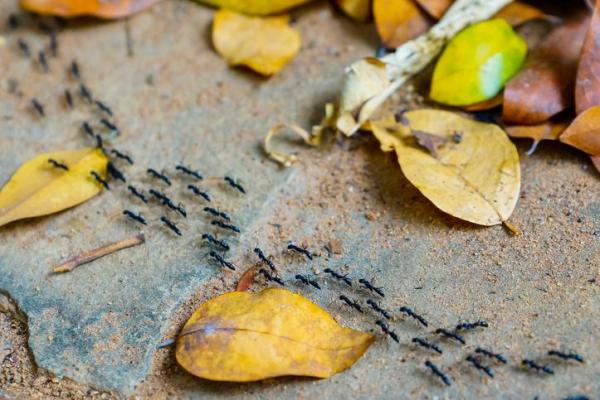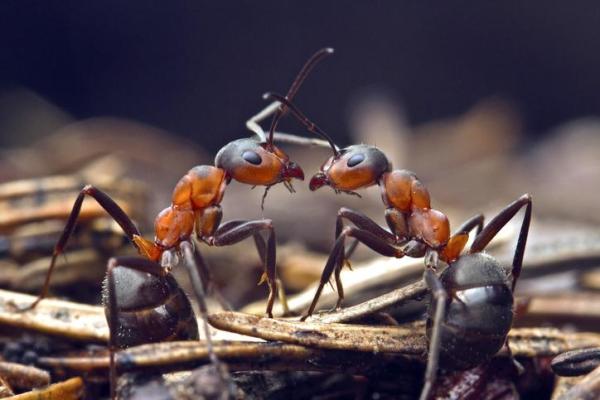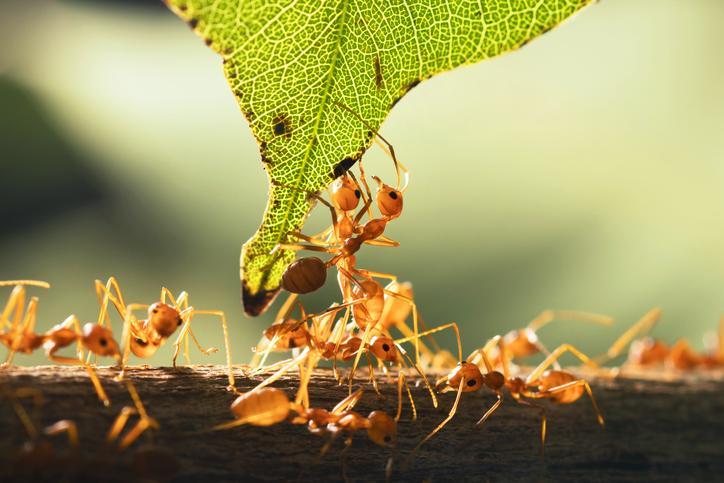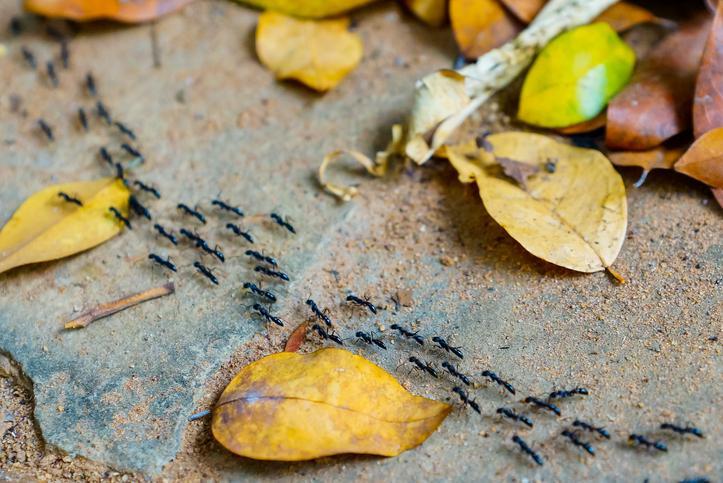How Do Ants Communicate?


Effective communication is a cornerstone of survival in the animal kingdom. It fosters cooperation, alerts to impending threats, and maintains the integrity of social structures. From the intricate dances of bees to the haunting calls of whales, the diverse forms of communication showcase the remarkable adaptability of life on Earth. Ants, highly social insects, exhibit a particularly sophisticated level of organization within their colonies. This section delves into their complex social structures, where distinct castes and cooperative behaviors play a critical role in the colony's success.
In the following AnimalWised article, we will explain how ants communicate, detailing the various methods they employ and emphasizing their significance.
Importance of ant communication
The success of ant colonies hinges on their ability to coordinate complex tasks seamlessly. Through sophisticated communication mechanisms, ants can mobilize workers for specific activities, such as foraging, nest construction, or caring for the brood.
Chemical signals, known as pheromones, serve as a crucial communication channel, allowing ants to mark food sources and trails, guiding their fellow workers to the most abundant resources.
On the other hand, tactile interactions, such as antenna contact, further reinforce these signals, ensuring that the colony's workforce is deployed effectively.
In the face of danger, ants employ a range of communication strategies to coordinate their defense efforts. When danger arises, scout ants alert the colony through a combination of chemical signals and alarm dances. Upon receiving these alerts, ants mobilize, working together to repel intruders or construct fortifications around the nest.
Communication also plays a vital role in maintaining social cohesion within ant colonies. Pheromones and tactile interactions facilitate the exchange of information about tasks, roles, and social hierarchies, ensuring that each ant understands its place within the colony. This harmonious social structure promotes cooperation, reduces conflict, and optimizes the colony's overall functioning.
These communication mechanisms have played a critical role in the evolutionary success of ants, making them one of the most dominant and persistent groups of insects on Earth. In the following sections, we will take a closer look at each of these sophisticated communication mechanisms.
Delve deeper into the fascinating world of ants and uncover the intricate structures that enable their remarkable communication abilities in our article on ant anatomy.
Chemical communication
Ants rely heavily on a unique form of chemical communication known as pheromones to convey information and coordinate their actions within the colony. These chemical signals, produced through glandular secretions, serve as the primary language of ants, enabling them to navigate, forage, and maintain social cohesion.
Ants possess a variety of glands that specialize in producing pheromones, each with its specific role in communication. These glands release chemical signals directly into the environment, allowing other ants to detect and interpret the information. This direct and efficient method of communication facilitates the rapid exchange of essential information within the colony.
Trail pheromones are a particularly important type of pheromone used by ants to mark paths and guide their fellow workers. As ants move, they deposit these pheromones, creating a chemical trail that serves as a navigational aid. This simple yet effective communication method enables ants to exploit food sources efficiently and minimize unnecessary exploration.
When ants discover a food source, they lay down a trail of pheromones leading back to the nest. This chemical trail serves as an invitation to other workers, informing them of the location and potential value of the food source. By following this pheromone trail, ants can efficiently exploit new food resources, maximizing the colony's foraging success.
The intensity and composition of trail pheromones convey information about the quality and quantity of the discovered food. Stronger pheromone signals indicate a more valuable food source, attracting more ants to the location. This mechanism ensures that the colony can effectively allocate its resources and prioritize the exploitation of the most abundant and nutritious food sources.
Pheromones also play a fundamental role in the social organization of ant colonies, ensuring cohesion and order through straightforward chemical cues. These chemical signals regulate interactions between ants, maintain social hierarchies, and facilitate the coordinated execution of colony-level tasks.
Furthermore, ants utilize pheromones to distinguish between colony members and potential intruders. By recognizing the unique pheromone signatures of their nestmates, ants can maintain the integrity of the colony and prevent the infiltration of potential threats.

Tactile communication
Tactile communication is another foundational aspect of ant interaction, and it plays a pivotal role in information transfer and social cohesion within their colonies. Unlike other forms of communication that rely on visual or auditory cues, tactile communication utilizes physical contact to convey information directly and efficiently.
On one hand, there is antennation, or antennal contact, which is the primary form of tactile communication among ants. This intricate interaction involves the touching of antennae, serving as a straightforward yet effective means of information exchange. Ants can detect and interpret a variety of chemical cues present on their nestmates' antennae, gaining valuable insights into their identity, social status, and recent activities.
Not only that, but ants utilize antennation to exchange information about their environment, enabling them to adapt collectively to changing conditions. This direct physical contact allows ants to share details about potential threats, food sources, or changes in the nest structure. By rapidly and tangibly transmitting environmental information, ants can coordinate their responses and maintain the overall stability of the colony.
Trophallaxis, another essential aspect of tactile communication, involves the direct transfer of food between ants through mouth-to-mouth contact. This remarkable behavior not only serves as a means of nourishment but also strengthens social bonds and promotes colony cohesion. By sharing food, ants foster cooperation and reinforce their mutual dependence, contributing to the overall well-being of the colony.
For a closer look at the structure and function of ant brains, explore this other article.

Auditory communication
Ants, often perceived as silent and diligent creatures, possess a subtle yet effective auditory system. Their ability to detect vibrations plays a crucial role in their communication within the colony, enabling them to exchange information without relying on visual or tactile cues.
Ants' hearing abilities are facilitated by specialized sensory structures located on their bodies. While not as elaborate as those in some other species, these structures enable ants to perceive vibrations in their environment with remarkable sensitivity. These sensory receptors are typically located on the legs, antennae, and thorax, allowing ants to detect vibrations transmitted through the ground, nest structure, or other nearby objects.
Ants primarily detect auditory signals through substrate-borne vibrations, meaning vibrations transmitted through surfaces like the ground or nest structure. This sensitivity to substrate-borne vibrations allows ants to remain alert to environmental changes and communicate effectively within the colony without disrupting their often-undetected movements.
Vibrations serve as a key component in the ant communication repertoire, particularly in alerting the colony to potential threats and emergencies. By generating and detecting vibrations, ants can convey crucial information about impending danger, enabling the colony to respond rapidly and cohesively.
Ants utilize vibrations as alarm signals to communicate the presence of predators. When a threat is detected, scout ants or those directly encountering the danger generate vibrations that propagate through the substrate, alerting other colony members to the impending danger. This swift communication method enhances the collective ability to respond cohesively to external threats, whether by deploying defensive strategies or seeking refuge within the nest.
In times of emergencies, such as nest disturbances or natural disasters, vibrations become a means of coordinating the colony's response. Ants generate specific vibrational signals that trigger organized and rapid reactions, allowing the colony to adapt and ensure the safety of its members. These vibrational signals may initiate collective relocation efforts, nest fortification, or other coordinated actions aimed at mitigating the threat and preserving the colony.
To learn more about the life cycle of ants, including their birth, read our informative article.
If you want to read similar articles to How Do Ants Communicate?, we recommend you visit our Facts about the animal kingdom category.
- Jackson, D., & Ratnieks, F. (2006). Communication in ants . Current Biology Volume 16, No 15. Available at: https://www.cell.com/current-biology/pdf/S0960-9822(06)01834-3.pdf
- Fioravanti, C. (2018). The chemical language of insects . Investigation. Available at: https://revistapesquisa.fapesp.br/es/el-lenguaje-quimico-de-los-insectos/
- López-Riquelme, Germán Octavio. (2008). Ants as model systems for complex behavior: Neurobiological bases of chemical communication and division of labor in ants. Doctoral Thesis of the National Autonomous University of Mexico. Available at: https://www.researchgate.net/profile/German_Lopez-Riquelme/publication/200819205_Hormigas_como_sistemas_modelo_para_el_comportamiento_complejo_Bases_neurobiologicas_de_la_comunicacion_quimica_y_la_division_del_trabajo_en_las_hormigas/links/00b7d521183d555 c24000000/Ants-as-model-systems-for-complex-behavior-Neurobiological-Bases-of- -chemical-communication-and-the-division-of-labor-in-las-ants.pdf
- López-Riquelme, Germán Octavio, & Ramón, Fidel. (2010). The brave new world of ants . TIP. Magazine specialized in chemical-biological sciences. Available at: http://www.scielo.org.mx/scielo.php?script=sci_arttext&pid=S1405-888X2010000100004&lng=es&tlng=es.
- Ryabko, B and Reznikova, Z. (1996). Study of the communication system and cognitive abilities of ants . Iberian Association of Myrmecology. Available at: http://www.mirmiberica.org/node/234







